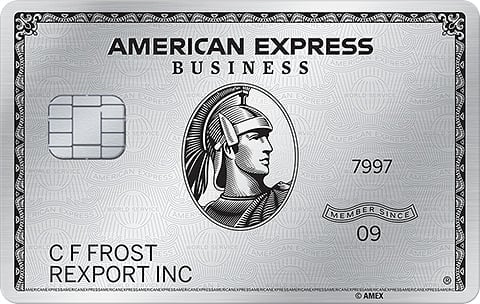What Is a Business Credit Card and How Do You Use One?
Business credit cards can help you manage cash flow, earn rewards and build business credit history.

Many, or all, of the products featured on this page are from our advertising partners who compensate us when you take certain actions on our website or click to take an action on their website. However, this does not influence our evaluations. Our opinions are our own. Here is a list of our partners and here's how we make money.
Business credit cards are great tools for managing your company’s cash flow. You can use a business card to pay an invoice, buy supplies or adapt to an emergency. Then, when revenue comes in, you can pay down your balance. Business credit cards can also offer rewards and streamline your bookkeeping.
Ready to pick a card? Here are our top choices. Read on to learn more about how business credit cards work.
What is a business credit card?
A business credit card is a revolving line of credit designed for the way companies spend money. For instance, business cards tend to have higher limits than personal credit cards. They may also reward common business purchases, like advertising and software expenses.
Using a business credit card helps clearly separate your personal and business expenses. You can link a business credit card to your employer identification number (EIN), if you have one, which can help you build business credit. Business cards generally won’t impact your personal credit unless you’re delinquent.
How do business credit cards work?
In general, business credit cards work a lot like personal credit cards:
- Charge expenses to the card. Use your card when you buy something for your business. You can spend up to your credit limit, which is the maximum set by the card issuer. (In general, though, try to keep spending well below your limit.)
- Receive your statement. The issuer will send you this document every month. It includes details about everything you used your card for, along with the total amount you owe and when it’s due.
- Pay down your balance. If you can pay your entire statement before the due date, you won’t owe any interest. You have the option to carry a balance and pay it down more slowly, but that will come with interest costs. Interest rates on business cards typically range from 18% to 28%, which means they can get expensive.
- Sync your transactions with your accounting software. Most business credit cards integrate with accounting software. You should be able to export your transactions to QuickBooks or whichever tool you use. That can make it easier to close your books at the end of the month.
How do business charge cards and corporate cards work?
Charge cards and corporate cards work a little differently from traditional business credit cards.
Business charge cards have no preset credit limit. That means your credit limit is flexible. The issuer will change it depending on factors like how much you spend and your repayment habits. But you need to pay the full balance each month.
Charge cards are best for businesses with strong cash flow that want to maximize rewards.
Corporate cards are issued to companies, not individuals. They usually include built-in spend management software. You can use that to issue cards to employees, limit how they’re used, collect receipts and monitor spending by department or budget.
These cards usually have a high spending limit and require you to pay down your balance in full at least monthly.
Corporate cards are best for corporations or LLCs with strong cash flow and several employees who spend money for the business.
Who can get a business credit card?
Business credit cards are available to anyone who earns income outside a traditional W-2 job. That includes independent contractors, freelancers and people with side hustles.
Approval for a business card is based mainly on personal credit history. You can qualify with no revenue and minimal time in business as long as you have good-to-excellent personal credit. That’s typically a personal FICO score of at least 690.
Corporate cards are an exception. Those are usually only available to registered businesses, and approval is mostly based on your business’s financial history.
Benefits of business credit cards
- Separating business expenses. Every entrepreneur should draw a clear line between their business and personal spending. Putting all your business expenses on a dedicated business credit card is an easy first step.
- Rewards. Earn either cash back or travel points for every dollar you spend. You can use those rewards on yourself or the business.
- Discounts on business purchases. Some business cards offer discounts from brands like Adobe, Dell, Lyft and Apple. And many business travel cards give statement credits for flights, checked bags and more.
- Higher credit limits than personal cards. The minimum credit limit for some business cards starts at $10,000.
- Bigger sign-up bonuses, too. In general, card issuers expect business cardholders to spend more than personal cardholders do. That means you’ll have to spend larger amounts in your first few months to earn sign-up bonuses — but those bonuses can be huge, potentially worth more than $1,000.
- Building business credit. Business credit cards report payments to business credit bureaus. Making early or on-time payments can help strengthen your business credit score.
- Interest-free financing. Several business credit cards offer a 0% intro APR period of a year or longer. Business owners can leverage that perk to float inventory costs during slow seasons.
- Manage employee spending. Business owners can issue employee cards as needed to facilitate business spending. Some business cards let you have up to 99 employee cards on the same account. Other business cards have no limit on the number of employee cards you can have. And almost all business cards let you set spending controls to limit how those cards are used.
- Fraud protection. Card lost or stolen? Business credit cards limit your liability for unauthorized use, like personal cards do. You generally won’t be on the hook for more than $50 if one of your business credit cards is used illegitimately.
Drawbacks of business credit cards
- No Card Act protections. The Credit Card Accountability Responsibility and Disclosure Act of 2009 (Card Act) doesn’t extend to business credit cards. That means interest rates can change with little warning. You may encounter fees you are not used to on personal credit cards.
- Late payments can hurt your personal credit. Most business credit card issuers report late payments and delinquencies to personal credit bureaus, not just business credit bureaus. That would likely cause a drop in your personal credit score.
- You’ll be personally liable for unpaid debts. Most business credit cards require a personal guarantee. That means that you will have to pay the balance if your business can’t, which puts your personal assets at risk if your business goes under.
- High interest rates. Interest rates for business credit cards are usually higher than rates for business loans or business lines of credit. If your goal is to finance a large purchase, choose one of those options instead.
- Most require good to excellent credit. Your business credit card options are limited if your personal credit score is below the “good” range (a FICO score of at least 670), though there are a few business credit cards for fair credit. Make a plan to work toward a good credit score — it’ll open up more financing options.
How to use a business credit card
Here’s how you can get the most out of your business credit card.
1. Pay your bill on time and in full
Credit cards have higher annual percentage rates (APRs) than most other forms of business financing. If you don’t pay off your bill in full by the due date, you’ll owe interest on the remaining balance. Try to avoid paying interest whenever you can.
If you need flexible financing but consistently carry a balance, a business line of credit may be a lower interest option if you qualify.
2. Monitor your credit limit
Be mindful of how much of your credit you use. Try to keep your balance well below your credit limit so that you have plenty of credit available if you need it in a pinch. Approaching your limit may also make potential lenders worry about your business’s cash flow. That could make it difficult to access additional financing.
Your credit limit isn’t fixed forever, though. Card issuers regularly evaluate how people use their cards, and it’s common for them to increase your credit limit after your first few months of usage. But you can request a credit limit increase, too. That can reduce your credit utilization and give you access to more capital.
3. Earn and use rewards
Most business credit cards offer rewards. Start with a cash-back business credit card with extra earnings on the categories most relevant to your business, like gas or office supplies. If you don’t have specific spending patterns, a flat-rate cash-back card can rack up rewards on all your expenses.
Cash-back earnings come in the form of cash back or points. You can redeem those as a credit to lower how much you owe. Or you can transfer your points to a partner, like an airline or hotel chain.
If you or your staff travel often, you might want a travel business credit card that offers more specific rewards. Those include miles on your preferred airline, status at your preferred hotel chain, lounge access or points that can be redeemed for travel.
4. Deduct interest and annual fees on your taxes
You can deduct the expenses associated with maintaining a business credit card, including annual fees, on your business taxes. (There are plenty of no annual fee business credit cards, though.)
Plus, when you use your credit card for your business spending, it should be easy to monitor your business expenses. You can deduct those too.
5. Put limits on employee cards
Most business credit cards let you issue employee credit cards, usually for no additional fee. That can give your employees the power to make purchases on behalf of your business.
Often, you can set up controls that limit the use of these cards. You should also have clear policies around which employees can get a card and what they’re allowed to use it for.
If your company is larger and you want more advanced spending controls, explore corporate cards.
🤓 Nerdy Tip
Thinking about using a business credit card for your personal expenses? That might not be allowed. When you sign off on a card’s terms and conditions, you often agree that you will only use your business credit card for business expenses. Rely on personal credit cards for your personal spending instead. How to use a business credit card as a startup
If you have good or excellent credit (generally defined as a FICO score of 690 or higher), business credit cards are available to new businesses.
If you’re starting a business, you can use a business credit card to do the following:
- Access financing. Startups don’t generally have access to business loans, but credit cards offer access to short-term, flexible financing.
- Get zero-interest financing, especially. You can use a business credit card with a 0% APR intro period to pay off purchases over time with no interest.
- Earn a sign-up bonus. If you meet certain usage requirements, like using a business credit card to spend a certain amount of money in your first few months of having it, your card issuer may give you a reward in the form of cash or points.
- Build your business credit. Using a business credit card and paying your bill on time can help your business build its credit.
- Organize your finances. Separating your business and personal finances is important for every business owner. Opening a business credit card, using it for your business purchases and syncing it with your accounting software is one way to keep the two apart.
Article sources
NerdWallet writers are subject matter authorities who use primary,
trustworthy sources to inform their work, including peer-reviewed
studies, government websites, academic research and interviews with
industry experts. All content is fact-checked for accuracy, timeliness
and relevance. You can learn more about NerdWallet's high
standards for journalism by reading our
editorial guidelines.
On this page
More like this
Related articles







